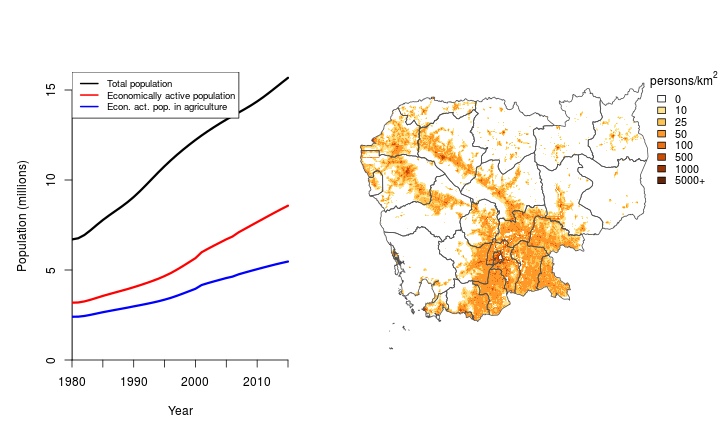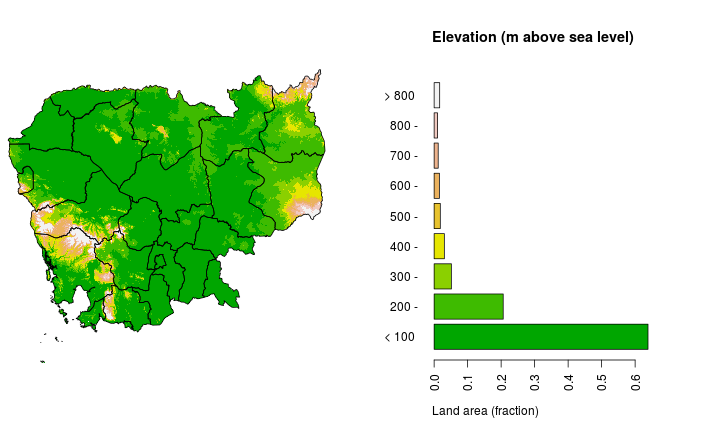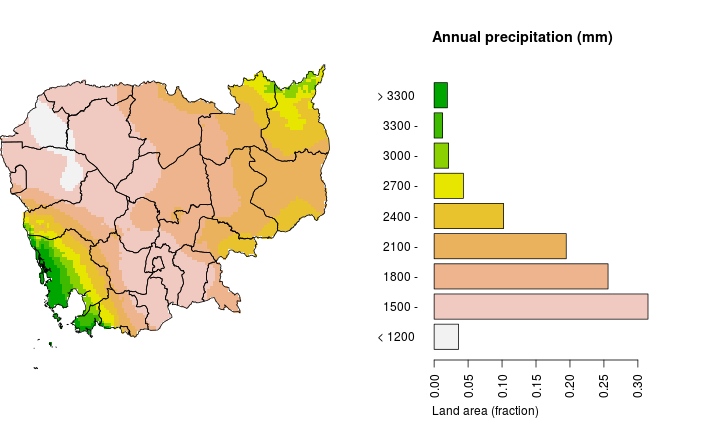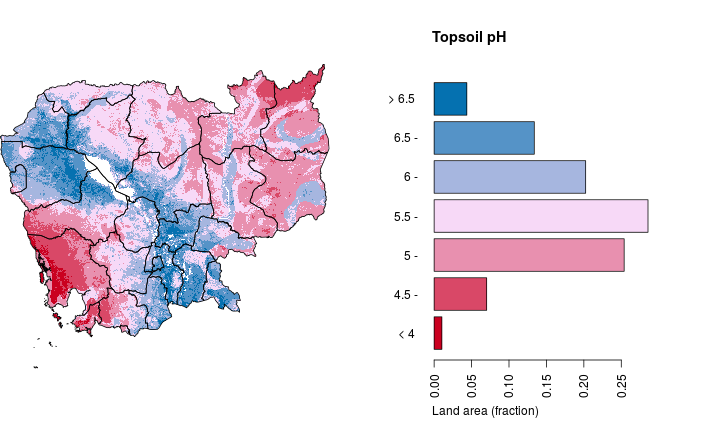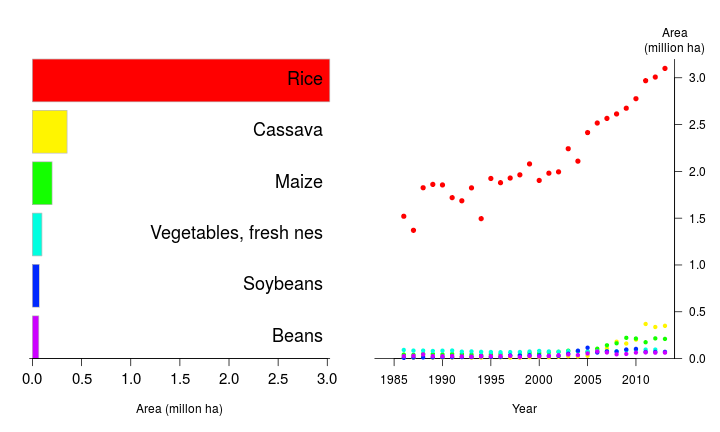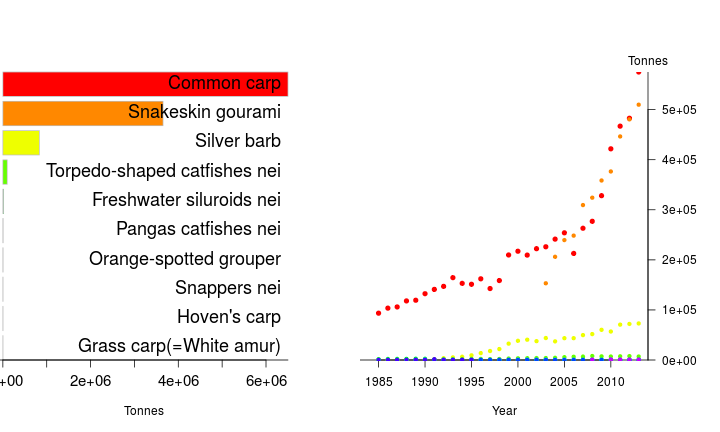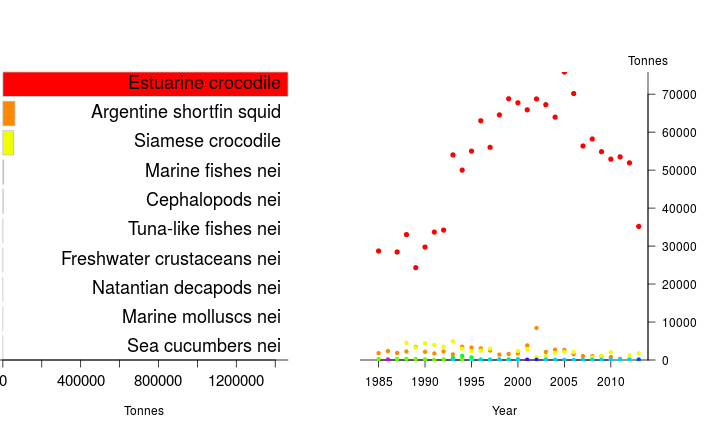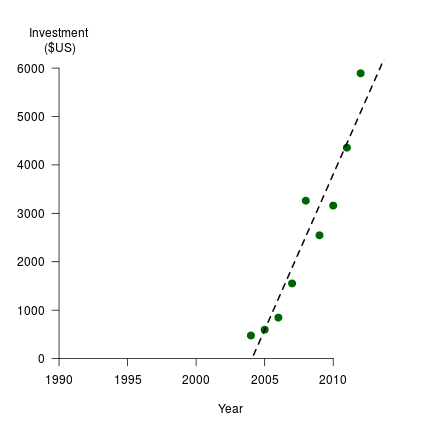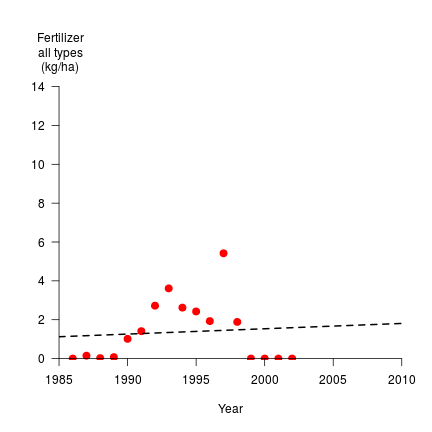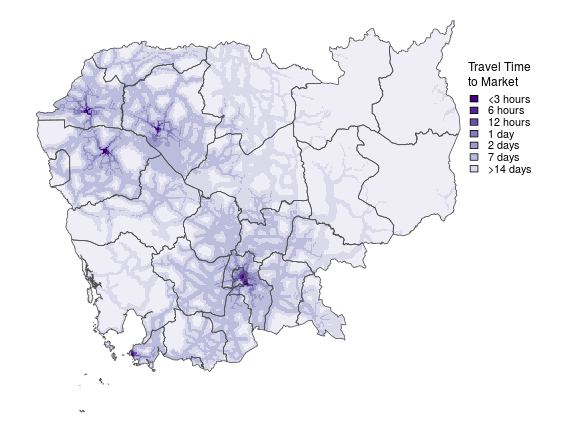Cambodia¶
Introduction¶
USAID’s Feed the Future Initiative in Cambodia focuses on rice, fisheries, and horticulture value chains. It makes investments in projects that increase agricultural productivity and diversification, capacity to meet food and other nutrition needs, rural incomes and equitable growth, agricultural and nutrition knowledge, natural resource management and resilience to climate change, and an enabling economic environment. The list of specific activities and research projects can be found here.
Cambodia is involved in several other FtF Innovation Labs for Collaborative Research, including the Lab for Nutrition. The Lab focuses on research that seeks to understand the impact of aquaculture production and consumption on diets and nutrition, as well as the value of nutrition programming in projects purposed to increase farm income. The Lab for Horticulture focuses on advancing water- and labor-saving technologies and practices for smallholder farmers. The Lab for Integrated Pest Management has several research projects, including one on ecologically-based participatory pest management in areas with large agricultural sectors but high biodiversity. The Lab for Aquaculture and Fisheries has a strong emphasis on policy, governance and climate change issues. The project also focuses on the snakehead industry, working toward developing alternative feeds and value-added processing techniques.
Cambodia is located between a latitude between 9.9 °N and 14.7 °N. The total land area is about 177 thousand km2. The country is administratively subdivided into 25 Khêt (Provinces), and these are further sub-divided into 178 Srok (Districts).
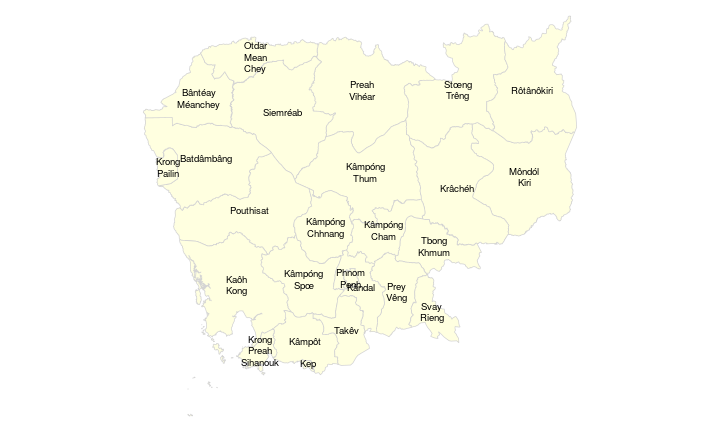
Administrative Divisons Map
The provinces of Cambodia
Human development¶
Population¶
Cambodia has about 15.7 million inhabitants. The population has increased 2 fold over the past 30 years. The economically active population is 8.6 million, 64% of which is employed in agriculture (down from75% in 1985). The rural population was 86% in 1985 and now it is 79%.
Development¶
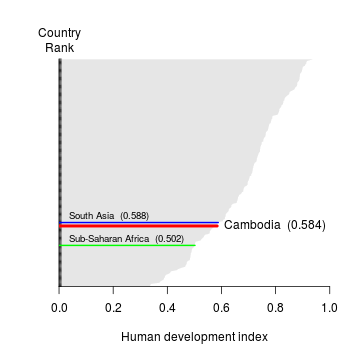
Human Development Index ranking and value
Human Development Index ranking for Cambodia. Data source: UNDP.
Gender¶
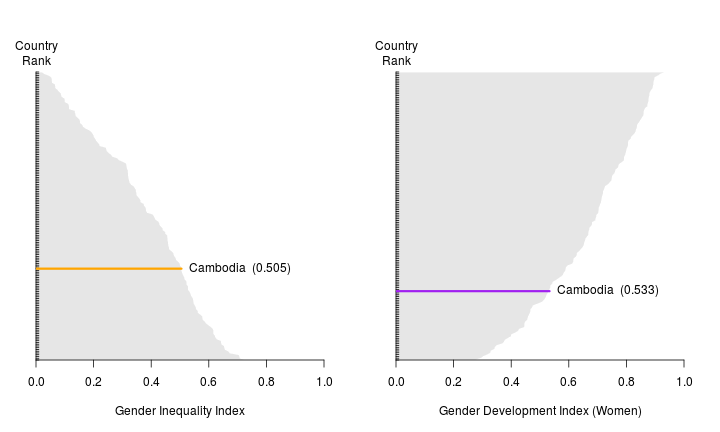
Gender Inequality and Development Indexes
Gender Inequality and Development Indices for Cambodia. Data source: UNDP.
Health and nutrition¶
Life expectancy at birth in Cambodia reduced from merely 42 in 1970 to 72 in 2013 (UNICEF, 2014). Under-five mortality is currently about 3.5% (National Institute of Statistics et al., 2015; UNICEF, 2014). Stunting, wasting, and underweight estimates declined substantially from 45%, 17%, and 39% in 2000 to 32%, 10%, and 24% in 2014, respectively (National Institute of Statistics et al., 2015). All three child anthropometric indicators are higher in rural areas than urban, especially stunting and underweight. This was not the case for wasting in 2010, where rates were similar between urban and rural areas (11.6 and 10.8, respectively), possibly indicating a heightened prevalence of acute malnutrition in urban areas during the survey year. The Preah Vihear/Steung Treng and Kampong Chhnang divisions have particularly high rates of all three child anthropometric measurements. However, Pursat faces the highest burden of severe undernourishment (< -3 SD) in both stunting (18%) and underweight (8%, National Institute of Statistics et al., 2015).
According to the 2010 Cambodia Demographic and Health Survey (CDHS), 6% of women have short stature (height < 145 cm). About 19% of women are underweight (BMI < 18.5, National Institute of Statistics, Directorate General for Health, & ICF Macro, 2011). According to a BMI ≥ 25, 11% percent of women are overweight or obese, up from 6% in 2000 (National Institute of Statistics et al., 2011). If the overweight threshold for Asian populations (BMI ≥ 23), more women would be considered overweight. Urban women have higher rates of overweight and obesity and lower rates of underweight and short stature than rural women. Mondol Kiri/Rattanak Kiri has much higher rates of women with short stature than any other province. The highest wealth quintile has over twice the prevalence of overweight (14%) than the lowest wealth quintile (5%).
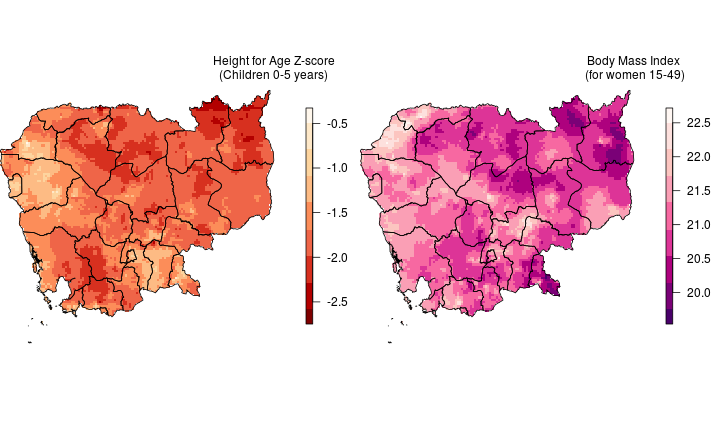
Child height-for-age Z-score and women’s body mass index
Average height-for-age Z-score for children (a child with a score less than -2 is considered stunted), and body mass index for women. Data source: DHS.
Micronutrients¶
No comprehensive nationally representative micronutrient survey has been conducted since 2000. The 2014 CDHS has been conducted, and preliminary results of a few indicators have been reported. Similar to 2010, 56% of children under five and 45% of women have some form of anemia (National Institute of Statistics et al., 2015). Poor and rural women and children are more likely to be anemic than urban and wealthy women and children. Regional disparities of anemia seem to exist but are not consistent between surveys. This variation may be explained by the inaccuracy of HemoCue finger prick hemoglobin testing. In 2010, less than two percent of children received iron supplements in the last 7 days, but 57% were given deworming medication in the previous six months, twice the proportion in the 2005 CDHS. During the most recent birth, 57% of women took iron tablets or syrup for 90 days or more (National Institute of Statistics et al., 2011). On average, women who have four or more children are more likely to be anemic. An estimated 83% of households use iodized salt (National Institute of Statistics et al., 2011). In 2010, 43.8% of women received a vitamin A dose postpartum, while 45% received iron/folate (National Institute of Statistics et al., 2011). Accurate biomarker micronutrient data is needed at the national level in Cambodia.
Cereals, most commonly rice, contribute about two thirds of caloric energy in Cambodian diets (WFP, 2008). It is estimated that between 11-19% of the population (depending on the season) had inadequate diets in 2008 (CDRI, 2008; WFP, 2008). Cambodians consume few animal products and low diet diversity in general, increasing the likelihood of micronutrient deficiencies. Vegetables are eaten frequently; fruits infrequently. Fish contribute the majority of protein calories in the diet. Increased fish consumption, especially whole fish, can greatly improve the iron, calcium, vitamin A, and zinc status of Cambodians. More dietary, nutritional, and micronutrient surveys are needed to develop appropriate interventions.
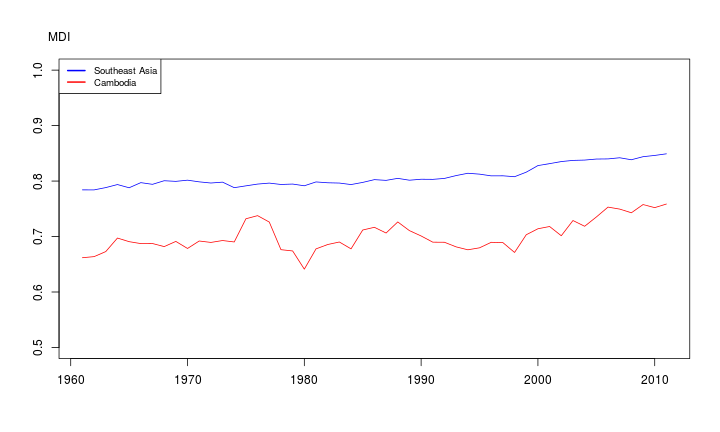
MicroNutruent Density Index
Micronutrient Density Index (MDI) between 1961 and 2011. Source: Beal et al.
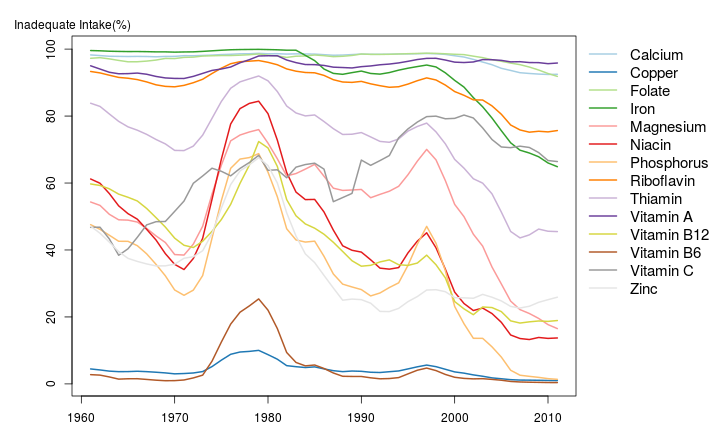
Prevalence of Inadequate Nutrient Intake
Estimated prevalence of inadequate intake (%) of micronutrients between 1961 and 2011. Source: Beal et al.
Land and water resources¶
Elevation¶
The elevation of Cambodia is between -10 and 1710 meters above sea level. Half the land area is below 70 meter and in between 20 and 130 meter.
Climate¶
Cambodia has a tropical monsoon climate with two distinct seasons. The monsoon season is from May to October, with the other months considered to be the dry season. Rainfall peaks at two times in the monsoon season, June and September/October. Rainfall averages vary from 1,000 in western Cambodia to 4,700 in southern Cambodia (FAO AQUASTAT).
The annual average temperature in Cambodia is between 19.8 and 27.8 °C. The median annual average temperature is 27.1 °C and half the land area has an annual average temperature between 26.4 and 27.4 °C. For more details see the monthly temperature maps. For projected future climate change, see these maps.

data source: WorldClim
Average annual mean temperature (°C) for 1950-2000 in Cambodia. Source WorldClim
The annual total precipitation in Cambodia is between 1100 and 4160 mm. The median is 1700 mm and half the land area has an annual total precipitation between 1400 and 2030 mm. For more details see the monthly precipitation maps. For projected future climate change, see these maps.
Soils¶
Water¶
Cambodia’s hydrological system is dominated by the Mekong river and Lake Tonlé Sap, the largest freshwater lake in southeast Asia. The Mekong river flows into Cambodia from Laos in the north and connects to Lake Tonlé Sap via the Tonlé Sap river. The Tonlé Sap river changes directions during the course of the year, with the overflow of the Mekong filling the lake after monsoon rains, and the lake draining back into the river in the dry season. Hence, the extent of the Tonlé Sap changes dramatically based on the season.
Cambodia’s water resources are mostly used for irrigation (Yu and Diao 2011). Irrigated areas in Cambodia include the margins of Lake Tonlé Sap and the lower Mekong delta in the southeast. More than 95% of the irrigated land is used for rice production. However, despite the large potential given the abundant water resources, only 9% of the total cultivated area is irrigated in 2006. It might be possible to irrigate three times as much land (FAO AQUASTAT).
Cambodia has readily accessible groundwater resources in lower parts of the country, and the use and intensity of groundwater extraction has been increasing in recent years. There is not much information available about groundwater quality in Cambodia (WEPA 2010), but it appears to be generally adequate, with some issues around iron in Kandal province and salinity in the southernmost districts. Arsenic contamination might also be an issue (WEPA 2010).
There are only two low capacity dams in Cambodia. There is a proposed project near the confluence of the San and Srepok rivers in Stueng Treng Province, but the project has stalled due to local civil protests (FAO AQUASTAT).
In the Mekong Basin, there are a number of dam projects underway. These include 7 dams in Yunnan province (China) and the controversial Xayaburi dam in Laos. Although the dams may have benefits, they could also negatively affect river biodiversity and the fisheries sector. Capture fisheries account for a significant portion of the typical Cambodian diet, and flow reductions from upstream dams will affect the productivity of Cambodia’s fisheries (Dugan et al., 2010; Baran and Myschowoda, 2009).
Water infrastructure for both domestic and agricultural purposes is poorly maintained. National policies and associated funding reflect priorities to make improvements in irrigation and water infrastructure. Investment in irrigation infrastructure increased by 20 million dollars from 2007 to 2010 (Yu and Diao, 2011). Still, the use of irrigation still suffers from a lack of system maintenance due to expensive and unpopular farm-level fees and the unaffordability of farm equipment (Thomas et al., 2013).
The 2007 Law on Water Resource Management and the 2007 National Water Resources Policy support integrated water resources management and outline the policies related to water allocation, plans, and management. The state owns the water, and every citizen has the right to water for domestic and small farming activities. All other water uses require a permit. Farmers’ Water User Committees facilitate water management and plans. Groundwater use is not regulated or subject to fees (USAID, 2010c).
The Ministry of Water Resources and Meteorology is responsible for water resource management, policies, and irrigation.

Map of Irrigated Agricultural Land
Percentage of agricultural land that is irrigated. Data source: GMIA
Land tenure¶
Cambodia has a relatively advanced legal framework concerning land, but parts of this framework and controversial. The average landholding in rural places is just slightly greater than one hectare, and many individuals and families are either without land or close to it. The exact number of rural landless households is unknown, but was estimated to be between 20 and 40 percent in 2009 (GTZ, 2009; USAID, 2010c). This feature of the Cambodian agriculture sector is a main contribution to the perpetuation of poverty. State land (state public and state private) accounts for approximately 80 percent of Cambodia’s total land area.
The Cambodian Constitution upholds that all persons have the right to land bearing it has no conflict with public interests. Foreigners are not allowed to own land. Private, state, and collective ownership are the three forms of land ownership, but land can also be leased for indefinite periods of time. The government can sell or lease public or private state land. Over half of the country’s parcels have been registered (USAID, 2010c).
The 2001 Land Law recognizes indigenous communities’ rights to land, and mechanisms to enforce rights against third parties. The 2003 sub-decree on Social Land Concessions provide state private land to the poor and landless for domestic and housing purposes. In 2002, the government established the Land Administration Sub-Sector Program (LASSP) to oversee legal and institutional development, but this program has been criticized for not advancing the elements that secure tenure for the most vulnerable Cambodians. The 2005 Economic Land Concessions (ELC) institutes a legal framework for large-scale land allocation for development purposes or the private sector. Via this policy, the government can lease public or private state land to domestic or foreign firms, so long as the firm agrees to abide by established concessions. The 2008 Land Policy Declaration outlines land policy objectives, including the transparent management, distribution, and titling of land to achieve poverty alleviation and economic growth. The 2010 Law on Expropriation allows the government to regain land for purposes of public interest, but requires that the government give compensation to those whose land they expropriate (USAID, 2010c).
One of the biggest conflicts of interest is over the ELC and its enforcement. Private companies use over 7 percent of all land outside of protected areas for agro-industrial activities, but the rules of the game as established in the ELC (e.g., environmental and social assessments, cap on hectares used by one firm) have not been followed. Although the policy is purposed to bring growth by creating employment opportunities in rural areas, the experience thus far is that job creation is limited (Scheidel et al. 2013). Over 60 percent of concession land is in domestic possession, suggesting that domestic players are involved in land grabbing (Deininger and Byerlee 2011; Hall et al., 2011; Scheidel and et al., 2013). Weak enforcement of tenure rights has created opportunities for firms and individuals to obtain large landholdings for unproductive purposes. Land grabbing often affects indigenous communities and their land security most severely. Land disputes between the state and citizens and between families are somewhat common; the Cadastral Commissions is the judiciary body that handles land disputes, but processes have not been streamlined across regions (USAID, 2010c).
Food production¶
Crop production¶

Cultivation Distribution
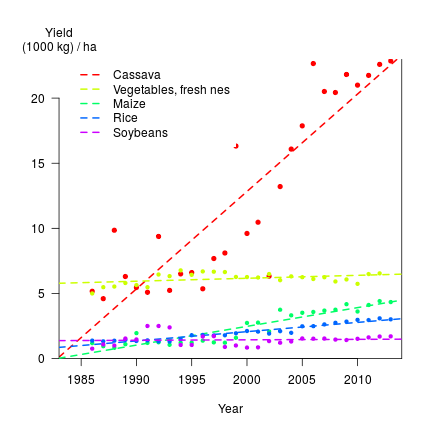
Crop Yield
Crop yield over the past 30 years, for the main five crops in Cambodia. Data source: FAO.
Annual linear growth rates of crop yield over the past 30 years, for the main five crops , were between 3.6 (Soybeans) and 748.1 (Cassava) kg/ha
Livestock¶
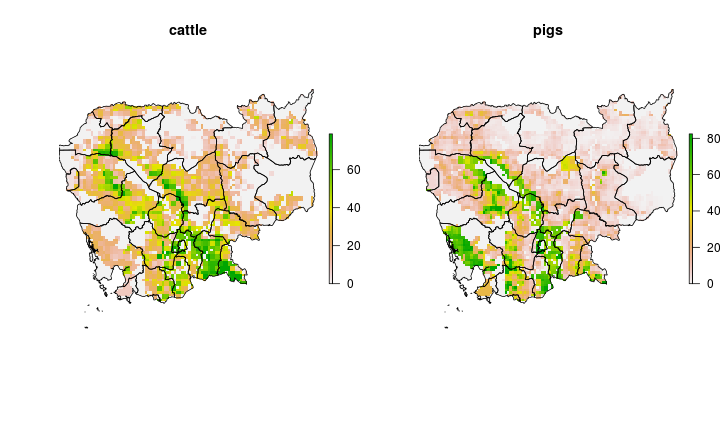
Livestock Distribution
Spatial distribution (head per km2) of cattle and pigs in Cambodia. Data source: Gridded Livestock of the World. More livestock maps.
Aquaculture and fisheries¶
The 2010-2019 Strategic Planning Framework for Fisheries is the most recent policy on fisheries in Cambodia. The fishery strategy focuses on advancing policy on three pillars: inland marine fisheries, inland and marine aquaculture, and post harvest and trade. It outlines the goals and strategic priorities of the government related to fisheries and fish management, including but not limited to the continuation of devolving management to provincial, commune, and community levels, enabling regulations on fishing generally, conducting participatory assessments of regulations and policies that affect fishing communities, and the development of short-term detailed plans that complement the longer-term policies. The strategy highlights several prioritizes, including small-scale operations, conservation and protecting of Upper Mekong pools, and a comprehensive plan for regional cooperation to address sweeping threats like climate change (Kingdom of Cambodia 2010).
Cambodia’s aquaculture sector is significant, but still overshadowed by marine fisheries and inland fisheries. FAO Fisheries and Aquaculture Department indicates that aquaculture accounted for less than 9.7% of total fish production.
Intensification¶
Key challenges to increasing yields in Cambodia include a lack of access to useful tools and the high costs and the poor quality of fertilizer (Economic Institute, 2006; CDRI, 2008; Tong, 2010; Yu, 2011). Over the past ten years, three of Cambodia’s main development strategies, the National Development Plan (a comprehensive policy document aimed at streamlining policy agendas), the Strategy for Agriculture and Water (the key policy framework for agricultural development), and the Agriculture Sector Strategic Development Plan (specialized policy goals on agriculture, fisheries, and forestry) have focused on these issues. Among other things, the plans focus on enhancing rice yields through improving access to and the quality of fertilizer and physical infrastructure, increasing crop diversification (especially those selling in foreign markets like cassava and maize), and sustainable fisheries and forestry resource management (Thomas et al., 2013; Yu and Diao, 2011). In part due to programs like the Cambodia Agriculture and Agribusiness Support Program (CAASP), rice production has doubled in the last decade and the country is now a rice exporter (Yu and Diao, 2011).
The Cambodian government subsidized fertilizer until the late 1990s, but ceased providing direct price support once the private sector engaged the market (Yu and Diao, 2011). Although some VAT exemptions on inputs are available (FAO, 2014b), high prices and adulteration discourage use (Yu and Diao, 2011). One study suggests that only about 50 percent of farmers use chemical fertilizer, but that almost all farmers use some kind of nonchemical fertilizer, such as animal manure and compost (Thomas et al., 2013). Some suggest that the Cambodian Agricultural Research and Development Institute (CARDI) and the Ministry of Agriculture, Forestry, and Fisheries may need to subsidize the cost of improved seed varieties (USDA-FAS, 2010).
Cambodia has several social safety net programs and has invested in the distribution of food and inputs in emergency situations. In 2012, the government created the Cambodia Food Reserve System to increase reserves of rice and seeds in times of crisis (FAO, 2014b). The Emergency Food Assistance Project has been used for similar purposes in the past, as have strategic rice stockpiles, which have also been used to control food price inflation. Retirement pensions and food-for-work programs have also been established.
Continued institutional weakness and support limits adaptive capacity. Evidence on public expenditure shows a generally low and at times decreasing trend in funds targeted at agriculture (Theng and Koy, 2010). To achieve policy goals, ministries associated with agricultural development need additional funding and more oversight (Thomas et al., 2013). The main agricultural research institute is the Cambodian Agricultural Research and Development Institute, which is primarily concerned with rice production.

Investment in Agricultural Research
Investment in Agricultural Research over time and by commodity groups ( data source: ASTI).
Yield gaps¶
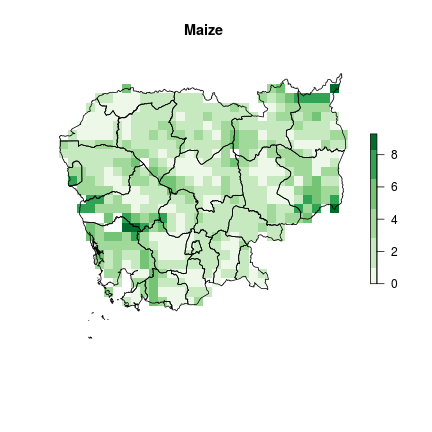
Yield Gap
Yield Gap (1000 kg / ha).
Selected research and development priorities and projects¶
The research programs within the CGIAR have several projects in Cambodia. The Climate Change, Agriculture and Food Security Research Program has one ongoing project in Cambodia. Seeds for Needs identifies the seed varieties most resilient to climate change, conducts large farmer-based experimentation networks with these seeds, and develops improved seed delivery systems. The Aquatic Agricultural System Research Program works primarily in the Tonle Sap region, assessing how to improve productivity and resilience of rice-fish farming systems as well as strengthen value chains and land and water management. The International Rice Research Institute has a strong research presence in Cambodia. Current research activities include the development of remote-sensing based information and insurance for rice crops, improved rice varieties, and enhanced knowledge dissemination techniques. The Water, Land and Ecosystems Research Program (WLE) is “working to achieve green, resilient and equitable growth.” The Volta River Basin is one of the focal regions of the WLE, and the project partners with institutions in Cambodia such as the Cambodia Development Resource Institute. The WLE currently has fourteen different research projects active in the Mekong River Basin, including topics like water governance, healthy rivers, river food systems, healthy landscapes and ecosystems, and building capacity.
WorldFish also has several programs in Cambodia, one of which focuses on freshwater capture fisheries in the Lower Mekong Basin. FAO’s priorities include increasing agricultural production via access to farm equipment, fertilizer, and other inputs, as well as enhancing nutrient and water management; improving consumer protection and market access through establishing a national food inspector system and post-harvest facilities, especially for fisheries; improving food security through focus on nutrition and diversifying production; enhancing natural resource management with special attention to biodiversity, conservation, and long-term strategies on protecting and managing fisheries; and climate change adaptation and disaster response (FAO Country Program Framework 2011-2015). Cambodia’s last Poverty Strategy Reduction Paper was released in 2006.
Nature conservation¶
About 26% of terrestrial Cambodia is under some form of protection (IUCN & WDPA 2015). This includes five national parks (Category II), one natural monument (Category III), 16 habitat/species management areas (Category IV), three protected landscapes (Category V) and three managed resource protected areas (Category VI), as defined by the IUCN. Across Cambodia UNESCO has designated the Tonlé Sap Lake as a Biosphere Reserve. Additionally, the country contains two Ramsar Wetlands of International Importance.
Cambodia is home to 114 species on the IUCN Red List of threatened and endangered species. This includes 22 listed as Critically Endangered, 41 as Endangered, and 51 as Vulnerable. However, Cambodia does not contain any sites noted by the Alliance for Zero Extinction as locations having an imminent risk of species extinctions.
There are a variety of major global or regional environmental non-governmental organizations that have current conservation programs operating in Cambodia. These include Conservation International (Greater Mekong), BirdLife International, Wildlife Conservation Society (Northern Plains, Southern Mondulkiri and Tonlé Sap), WWF (Greater Mekong), and Fauna and Flora International.
Global conservation prioritization methodologies have highlighted all of the terrestrial area of Cambodia as having conservation importance. This includes Biodiversity Hotspots (100% of the country), Global 200 Ecoregions (83%), Important Bird Areas (25%), Frontier Forests (10%), and regions considered to be the Last of the Wild (12%).
The map on the left shows biodiversity conservation priorities generated by combining numbers of vertebrate species, (excluding reptiles), IUCN threatened species, and small-ranged species (data from Jenkins et al. 2013) per 10 km2 cell. Thus, the areas with the highest values (shown here in red) not only have the greatest diversity of species in Cambodia, but also show those areas where species are or might become threatened with extinction. The map on the right highlights 17% of the terrestrial area of Cambodia containing the highest conservation priority values (a 17% target was chosen in accordance with the 2010 Convention of Biological Diversity). The same analysis at both regional and global scales highlights 0% and 71% of the nation respectively as meeting the CBD targets as defined in this analysis.
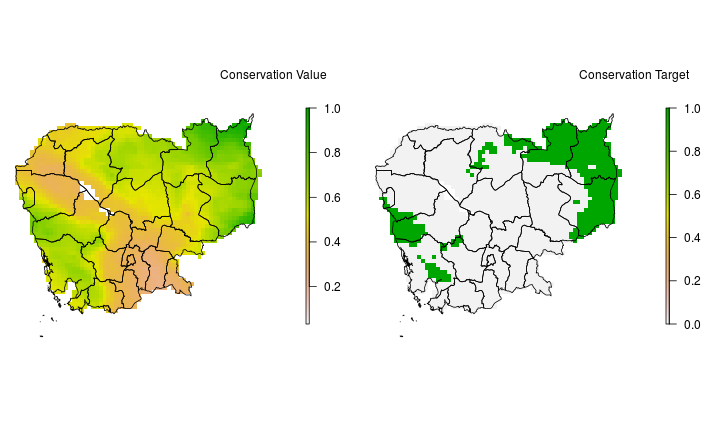
Conservation Priorities
Conservation Priorities.
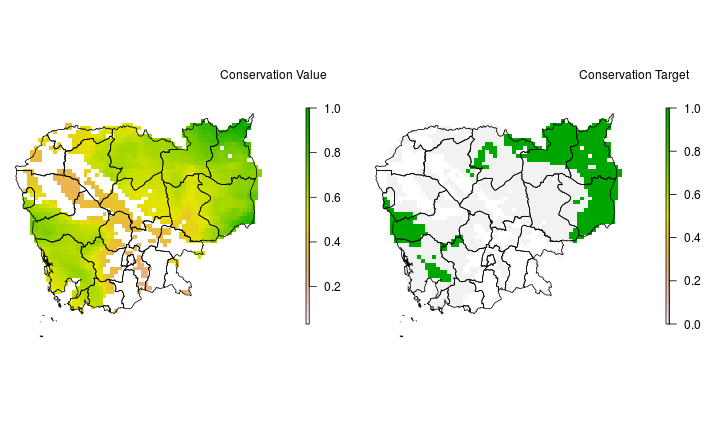
Conservation Priorities excluding Urban and Agricultural land
Conservation Priorities excluding Urban and Agricultural land.
Political system¶
The politics of the Kingdom of Cambodia, established in 1993, has been marred by a history of violence and authoritarianism. The 2013 election and its aftermath demonstrate its ongoing teetering between authoritarianism and democracy. The Cambodian People’s Party (CPP) took 68 of the 123 seats in the National Assembly, but the Cambodian National Rescue Party (CNRP) claimed that elections were rigged and outcomes distorted. Of all elections around the world in 2013, it ranked 69th of 73 elections in transparency, freeness, and fairness (Electoral Integrity Project 2013). After the result was announced, violence, protests, and fatalities ensued and the CNRP boycotted parliament. This was not the first instance of political conflict, however. Independent observers suggest that Cambodia has experienced consistent systematic and institutional inadequacies in election administration, and that the use of surveillance and intimidation techniques regularly occur before and during elections, especially to limit political competition in rural areas (NDI, 2015; Electoral Integrity Project, 2013; McCargo, 2005). Prime Minister Hun Sen and the CPP source funds from wealthy businessmen to carry out patronage, which includes giving gifts and contracts for construction projects (Un, 2005).
The two parties resolved the stalemate by forming electoral reform agreements. In future elections, a member of the opposition party will take the position of first deputy president of the assembly and the opposition party will take leadership of five of the ten standing committees. The standing committees will be composed of four members from each of the two main parties as well, with the fifth member as an independent (Penh, 2014). The next elections are scheduled for 2018.
Despite recent rapid economic growth and unprecedented poverty reduction (Kevreaksmey et al., 2015), political oppression, corruption, and bribery continue to perpetuate inefficiencies in programs and policy. The system lacks the financial and institutional capacity to support economic growth (McCargo 2005). The salaries of civil servants, along with most other public and private wages, are low (Kevreaksmey et al., 2015; Taliercio, 2014). Low wages have been the source of protest in the last year (Palatino, 2014).
Executive structure¶
Cambodia is a constitutional monarchy where the Prime Minister is head of government and the monarch is head of the state. The system parallels a parliamentary democracy, where the executive power resides in the assembly. The Prime Minister is dependent on the confidence of the assembly, and requires two thirds of the assembly’s approving votes to form a government. The monarch has no formal powers.
Hun Sen has been the Prime Minister since 1998, and began his tenure one year after the CPP took over the government with a violent coup. He was in power before that, however, starting in 1985. Sen is a defected Khmer Rouge member, and is considerably powerful.
Electoral Rules and party arrangement¶
The Cambodian parliament is bicameral. The National Assembly has 123 members who are elected by proportional representation for a five-year term. The Senate has 61 members; the King appoints two members, the Assembly elects two others, and the remaining 57 are elected by functional constituencies. The senate members serve five-year terms.
Although other parties exist and compete in elections, only the two main parties obtain seats in the legislature.
Decentralization¶
The local government arrangement in Cambodia has received attention in the last few years. In 2008, the interministerial National Committee for Sub-National Democratic Development (NCDD) was established to promote decentralization. That same year, the National Program for SubNational Democratic Development was released, aiming to reform and improve local administrations. Several tiers govern administration in Cambodia, some of which is specified in the Constitution and some in subsequent laws. The 2009 Organic Law on Decentralization and Democratic Development established the indirect elections of council members at the provincial and district levels. There are 25 provinces, including the capitol, and 197 districts (Open Development, 2014). The central government appoints the executive agents at these levels. The most local administrative unit is at the commune-level; there are over 1000 commune councils. Unlike provincial and municipal governments, constituents directly elect members of the councils every five years.
The decentralized administration assists in the creation of the national budget, land titling and registration, and related government functions. Decentralization is handicapped, however, by a lack of funds at the local levels (Kevreaksmey et al., 2015). This is particularly true at the commune level. Communes, for example, account for less than 5 percent of total public expenditures (UCLG, 2010).
References¶
- Baran, Eric, and Chris Myschowoda. “Dams and fisheries in the Mekong Basin.” Aquatic Ecosystem Health & Management 12.3 (2009): 227-234.
- Cambodia Development Resource Institute (CDRI). (2008). Impact of High Food Prices in Cambodia. CDRI.
- Dugan, Patrick J., et al. “Fish migration, dams, and loss of ecosystem services in the Mekong basin.” Ambio 39.4 (2010): 344-348.
- FAO. 2014b. Country Fact Sheet on Food and Agriculture Policy Trends: Cambodia. FAO. FAPDA.
- GTZ. 2009. Foreign Direct Investment (FDI) in Land in Cambodia. Eschborn, Germany: GTZ.
- Kevreaksmey, PHO, and et al. 2015. “A Research on Good Governance and Poverty Reduction in Cambodia.” Public Policy and Administration Research 5(1): 177–92.
- McCargo, Duncan. 2005. “Cambodia: Getting Away with Authoritarianism?” Journal of Democracy 16(4): 98–112.
- National Institute of Statistics, Directorate General for Health, & ICF Macro. (2011). Cambodia Demographic and Health Survey 2010. Phnom Penh, Cambodia and Calverton, Maryland, USA: National Institute of Statistics, Directorate General for Health, and ICF Macro.
- National Institute of Statistics, Directorate General for Health, & ICF Macro. (2015). Cambodia Demographic and Health Survey 2014 Key Indicators Report. Phnom Penh, Cambodia and Calverton, Maryland, USA: National Institute of Statistics, Directorate General for Health, and ICF Macro.
- Open Development. 2014. Government and Governance in Cambodia. Open Development. http://www.opendevelopmentcambodia.net/briefing/government-and-governance/.
- Palatino, Mong. 2014. “Why Cambodian Garment Workers Are on Strike Again.” The Diplomat. http://thediplomat.com/2014/09/why-cambodian-garment-workers-are-on-strike-again/.
- Penh, Phnom. 2014. “Back to Your Seats.” The Economist. http://www.economist.com/blogs/banyan/2014/07/cambodian-politics.
- Scheidel, Arnim, and et al. 2013. “Self-Sufficiency or Surplus: Conflicting Local and National Rural Development Goals in Cambodia.” Land Use Policy 34: 342–52.
- Taliercio, Robert R. 2014. From a Whole of Government to a Whole of Reform Approach? Reforming the Cambodian Civil Service. World Bank.
- Theng, V. and Koy, R. 2010. Review of Agricultural Policy and Policy Research. Phnom Penh, Cambodia. Paper prepared for the Cambodia Food Security and Agricultural Policy Stocktaking Roundtable.
- UN Children’s Fund (UNICEF). (2014). The State of the World’s Children 2015: Reimagine the Future: Innovation for Every Child. UNICEF.
- Un, Kheang. 2005. “Patronage Politics and Hybrid Democracy: Political Change in Cambodia, 1993-2003.” Asian Perspective 29(2): 203–30.
- USAID. 2010c. Property Rights and Resource Governance in Cambodia. USAID.
- USDA-FAS. 2010. Cambodia: Future Growth Rate of Rice Production Uncertain. USDA Foreign Agricultural Service.
- WEPA (Water Environment Partnership in Asia). No year. State of water environmental issues: Cambodia. (Available at: http://www.wepa-db.net/policies/state/cambodia/index.htm).
- World Food Programme (WFP). (2008). Comprehensive Food Security and Vulnerability Analysis (CFSVA): Cambodia. WFP.
- Yu, Bingxin, and Xinshen Diao. 2011. Cambodia’s Agricultural Strategy: Future Development Options for the Rice Sector. Washington DC: USAID.
